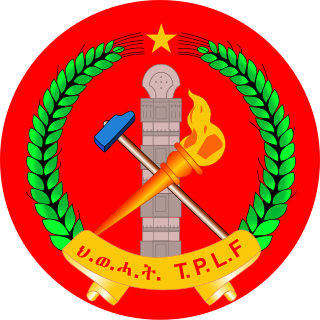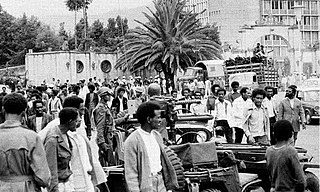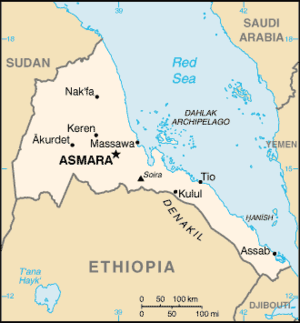
Eritrea is an ancient name, associated in the past with its Greek form Erythraia, Ἐρυθραία, and its derived Latin form Erythræa. This name relates to that of the Red Sea, then called the Erythræan Sea, from the Greek for "red", ἐρυθρός, erythros. But earlier Eritrea was called Mdre Bahri. The Italians created the colony of Eritrea in the 19th century around Asmara and named it with its current name. After World War II, Eritrea annexed to Ethiopia. Following the communist Ethiopian government's defeat in 1991 by the coalition created by armed groups notably the EPLF, Eritrea declared its independence. Eritrea officially celebrated its 1st anniversary of independence on May 24,1993.

Isaias Afwerki is an Eritrean politician and partisan who has been the first and only president of Eritrea since 1993. In addition to being president, Isaias has been the chairman of Eritrea's sole legal political party, the People's Front for Democracy and Justice (PFDJ).

The People's Front for Democracy and Justice is the founding, ruling, and sole legal political party of the State of Eritrea. The successor to the Marxist–Leninist Eritrean People's Liberation Front (EPLF), the PFDJ regards itself as a left-wing nationalist party, though it holds itself open to nationalists of any political affiliation. The leader of the party and current President of Eritrea is Isaias Afwerki. The PFDJ has been described as totalitarian, and under its rule Eritrea reached the status of the least electorally democratic country in Africa according to V-Dem Democracy indices in 2023.

The flag of Eritrea is the national flag of Eritrea. It was adopted on 5 December 1995. The flag combines the basic layout and colors from the flag of the Eritrean People's Liberation Front with an emblem of a wreath and an upright olive branch derived from the Eritrean flag from 1952 to 1962.

The Derg, officially the Provisional Military Administrative Council (PMAC), was the Marxist–Leninist military dictatorship that ruled Ethiopia, then including present-day Eritrea, from 1974 to 1987, when the military leadership or junta formally "civilianized" the administration but stayed in power until 1991.

The Eritrean People's Liberation Front (EPLF), colloquially known as Shabia, was an armed Marxist–Leninist organization that fought for the independence of Eritrea from Ethiopia. It emerged in 1973 as a far-left to left-wing nationalist group that split from the Eritrean Liberation Front (ELF). After achieving Eritrean independence in 1991, it transformed into the People's Front for Democracy and Justice (PFDJ), which serves as Eritrea's sole legal political party.

The Tigray People's Liberation Front, also known as the Tigrayan People's Liberation Front, is a left-wing ethnic nationalist, paramilitary group, and the former ruling party of Ethiopia. It was classified as a terrorist organization by the Ethiopian government from May 2021 until its removal from the list in March 2023. In older and less formal texts and speech it is known as Woyane or Weyané.

The Eritrean Liberation Front, colloquially known as Jebha, was the main independence movement in Eritrea which sought Eritrea's independence from Ethiopia during the 1960s and the early 1970s.

The Eritrean War of Independence was an armed conflict and insurgency aimed at achieving self-determination and independence for Eritrea from Ethiopian rule. Starting in 1961, Eritrean insurgents engaged in guerrilla warfare to liberate Eritrea Province from the control of the Ethiopian Empire under Haile Selassie and later the Derg under Mengistu. Their efforts ultimately succeeded in 1991 with the fall of the Derg regime.
The African independence movements took place in the 20th century, when a wave of struggles for independence in European-ruled African territories were witnessed.
The Marxist–Leninist League of Tigray (MLLT) was a semi-clandestine Hoxhaist Communist Party that held a leading role in the Tigrayan Peoples' Liberation Front (TPLF) in the 1980s. The majority of the TPLF leadership held dual membership in the MLLT, including Meles Zenawi, Prime Minister of the Federal Democratic Republic of Ethiopia from 1995 until his death in 2012.

The Ethiopian Civil War was a civil war in Ethiopia and present-day Eritrea, fought between the Ethiopian military junta known as the Derg and Ethiopian-Eritrean anti-government rebels from 12 September 1974 to 28 May 1991.
Mesfin Hagos is an Eritrean who was one of the founding members of the Eritrean People's Liberation Front (EPLF). In government, he was the Eritrean Minister of Defense during the 1990s.
The Battle of Afabet was a three-day battle fought from 17 March through 20 March 1988 in and around the town of Afabet, as part of the Eritrean War of Independence. The battle has been described as being the largest battle in Africa since the Second Battle of El Alamein. It has been described as the most significant battle in terms of military and political consequences since the Ethio-Somali War, alongside the 1989 Battle of Shire of the Ethiopian Civil War.
The First Battle of Massawa took place from 1977 to 1978 in and around the coastal city of Massawa. The port was besieged by the Eritrean People's Liberation Front (EPLF) against the forces of Ethiopia and was one of two battles in and around the city.
The Second Battle of Massawa took place in 1990 in and around the coastal city of Massawa. The offensive was conducted by both land and sea units of the Eritrean People's Liberation Front (EPLF) against the Ethiopian Army and resulted in the destruction of the Ethiopian 606th Corps.
The Siege of Barentu took place in 1977 in and around the town of Barentu. It was jointly laid to siege by the Eritrean Liberation Front (ELF) and the Eritrean People's Liberation Front (EPLF) against the forces of Ethiopia.

Ethiopia–Israel relations are foreign relations between Ethiopia and Israel. Both countries re-established diplomatic relations in 1992. Ethiopia has an embassy in Tel Aviv. Israel has an embassy in Addis Ababa.

Eritrea–Israel relations are foreign relations between Eritrea and Israel. Both countries established diplomatic relations in 1993 following Eritrean independence. Eritrea has an embassy in Ramat Gan and Israel had an embassy in Asmara, that was closed in 2022. Their ties were considered as very close, but after 2020 the relations worsened. Both Eritrea and Israel have shared access to the Red Sea.

The fall of the Derg, also known as Downfall of the Derg, was a military campaign that resulted in the defeat of the ruling Marxist–Leninist military junta, the Derg, by the rebel coalition Ethiopian People's Revolutionary Democratic Front (EPRDF) on 28 May 1991 in Addis Ababa, ending the Ethiopian Civil War. The Derg took power after deposing Emperor Haile Selassie and the Solomonic dynasty, an imperial dynasty of Ethiopia that began in 1270. The Derg suffered from insurgency with different factions, and separatist rebel groups since their early rule, beginning with the Ethiopian Civil War. The 1983–1985 famine, the Red Terror, and resettlement and villagization made the Derg unpopular with the majority of Ethiopians tending to support insurgent groups like the Tigray People's Liberation Front (TPLF) and Eritrean People's Liberation Front (EPLF).












